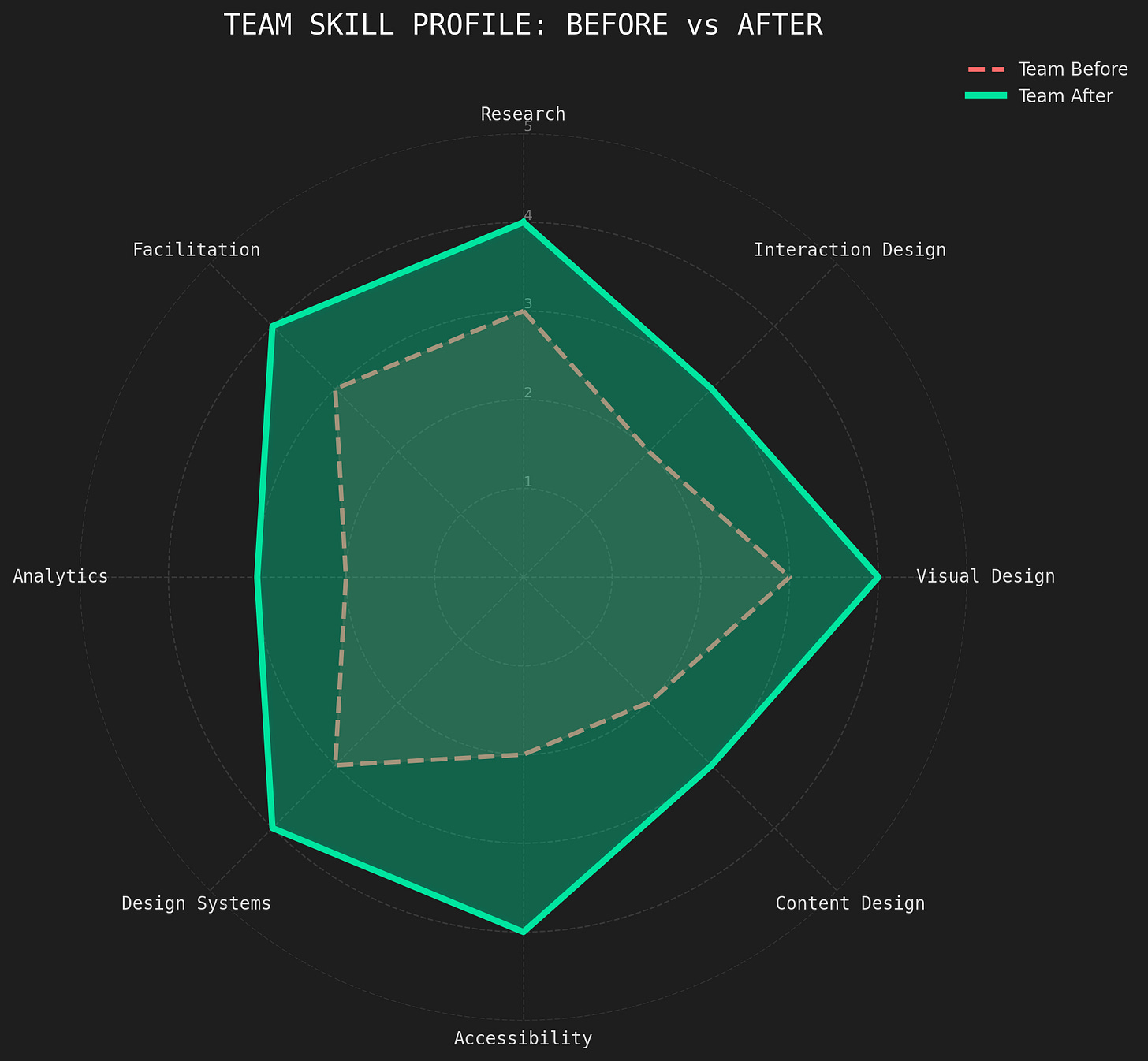The Real Work Begins After the Design Hire
#005: A collaborative, skills-first approach to hiring and developing designers with purpose.
Hiring designers is hard. But developing the team you already have? That’s harder — and far more impactful over time.
What most design leaders miss is that hiring and development are two sides of the same system. If you treat them separately, you’ll always feel like you’re patching holes. But if you connect them — if you create a shared, skills-based understanding of who’s on your team, what they’re great at, where they want to grow, and where the business is heading — you can build something far more durable than just headcount coverage.
Over the past several years, I’ve built teams inside large, complex organizations using a simple but powerful tool: a design skills matrix. This framework has helped me hire with clarity, grow talent with intention, and stand up entirely new functions that never would have emerged without this level of insight and collaboration.
Why Skills Mapping Matters
Most design orgs have strong people — but very few have clear visibility into what those people are actually best at, or how those strengths align with team needs. That lack of visibility leads to vague hiring, missed development opportunities, and designers feeling either underutilized or overwhelmed.
The skills matrix changes that. It gives you — and your team — a way to talk about capabilities that’s structured, repeatable, and deeply human.
Here’s how I use it:
Start by listing the critical skills your team and business require — from generative research, IA, and visual design, to design systems, accessibility, content, analytics, and facilitation.
Ask each designer to self-assess their confidence and proficiency in those skills using a 1–5 scale. I define a 5 as “able to teach this at a graduate level.”
Meet one-on-one to calibrate. This is where the real insight happens. I’ve had designers rate themselves low in areas where they’re gifted — and others rate themselves high in areas they’re just learning. The goal isn’t to grade — it’s to align.
Visualize the results. Radar charts or other visual summaries help you spot both individual growth opportunities and team-level gaps. When aggregated across a team, these visuals provide a snapshot of your actual capability — not just who’s on payroll.
Importantly: I position this as a developmental tool, not a performance review. It’s not about judgment — it’s about discovery.
Hiring With Insight, Not Instinct
Once you’ve mapped the team’s skills, hiring becomes far more intentional. You’re not just reacting to attrition or lobbying for headcount — you’re building capacity based on real need.
You can now:
Identify missing competencies tied to business goals (e.g., content design for a promotional experience, or accessibility expertise for an enterprise platform)
Hire for complementary strengths, not carbon copies
Spot areas where a new hire could accelerate growth for an entire team (e.g., pairing a senior design technologist with a team struggling to scale component usage)
This also prevents overloading your team with generalists when you need specialists — or vice versa. It gives you language to explain and justify hiring decisions, grounded in data and context.
Growing the Team You Already Have
Here’s where the framework shines: you don’t just use it to hire better — you use it to develop your people more effectively.
By setting a baseline of core skills collaboratively, you unlock rich development planning conversations. Designers can identify where they want to grow — and you, as their manager, can guide them toward growth that aligns with business needs. That might mean deepening a strength, building cross-functional range, or stepping into a leadership opportunity.
Because you see the full team picture, you can:
Suggest stretch projects that build bench strength
Pair senior and junior designers intentionally
Identify rising talent and future leaders
Create continuity across product areas through skill-based assignments
Building What's Next — Together
At multiple companies, I have used this approach to establish new design capabilities and teams — not because they were on a roadmap, but because the people and skills were there, waiting to be surfaced and directed.
Design Operations, Design Technology, Content Design, and Digital Accessibility teams I’ve helped launch didn’t begin as open roles — they emerged through this process. Without close collaboration with my team to understand their strengths, growth goals, and how those intersected with real business needs, none of those opportunities would have come to fruition.
That’s the part many leaders miss: your best people can often solve some of the business’s most critical problems, but only if you help surface the opportunity, set the context, and prioritize the space for them to step into it. If done thoughtfully, the value driven will be clear enough to support the creation of more formal structures and funding models to fuel further team and individual growth.
A Design Team That Grows Intentionally
When you use a skill matrix to connect hiring and development, you create something far more resilient than a job ladder or a role rubric. You create a living map of capabilities, potential, and purpose.
Coming Soon
I’m turning this framework into an interactive tool for design leaders. It’ll include:
A skills self-assessment template
Role and skill definitions
Team radar visualization tools
Personalized recommendations to guide hiring decisions
If you’re not already on the list, subscribe and you’ll get early access.
Question for You
Have you ever inherited a design team that was strong but imbalanced? What did you do to fix it?
Leave a comment and let me know — I may feature your story in a future issue.





